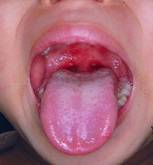Introduction
Enteroviruses are a group of small viruses that are made of ribonucleic acid (RNA) and proteins. They belong to a family of viruses which include poliovirus (Type 1,2 & 3) and non polioviruses (Coxsackie A & B viruses, Echoviruses and other Enteroviruses). They can remain viable at room temperature for several days and can survive the acidic pH of human gastrointestinal tract. The viruses are highly contagious and can cause widespread outbreaks.
Enteroviral infections cause a wide spectrum of illness among infants and children and are more likely to occur in crowded living conditions. Boys and girls are equally affected.
The most common form of transmission is by fecal-oral route and oral-oral route. The viruses can be found in the respiratory secretions (saliva, sputum or nasal mucosa) and stool of infected persons. Infection can occur by direct contact with secretions from an infected person or contact with contaminated surfaces or objects such as drinking glass or telephone or contamination of the hands with stool from an infected infant or toddler during diaper changes. Enteroviral infections can occur in outbreaks.
Signs and symptom
Non Polio Virus Infection

Sores in the mouth

Rashes & blisters on the hand
- Most people who are infected have no disease at all. The illness usually occurs within 2-5 days of exposure or ingestion of infected material. Enteroviral infections may present with mild flu-like symptoms with fever, muscle aches or rashes. Symptoms usually last for 3-7 days.
- They can have fever, painful vesicles on the tonsils, throat, painful swallowing and reduced feeding. It is commonly caused by Coxsackie A & B viruses. It lasts for 3-7 days.
- Hand foot mouth (HFM) disease (usually caused by coxsackievirus A16, enterovirus 71) presents with fever, sores in the mouth, rash with blisters on the hands, feet & buttocks and poor appetite. It is usually a mild disease and patients recover by 7-10 days. Lesions heal with or without treatment.
- Rarely enteroviral infections may present as meningitis and myocarditis. Poliovirus infections present as poliomyelitis.
Poliovirus infections
- May cause paralytic or non-paralytic infection
- Non paralytic infections present with nonspecific symptoms including meningitis (infection of the layers covering the brain) and muscle weakness
- Paralytic form is similar to the non-paralytic form but there is paralytic of the muscles and changes in blood pressure. Paralysis of the respiratory muscle can cause difficulty in breathing.
Complications
Enteroviral infections (seen in children) are generally mild illnesses and most recover. However, it may be severe in young infants. Complications that may be seen include :
- Paralysis, meningitis or encephalitis (inflammation of the layers covering the brain).
- Inflammation of the heart and heart failure (myocarditis).
- Babies born to mothers who have enteroviral illness at the time of delivery may acquire the infection and are at a risk of developing very severe infection.
- Symptoms that may indicate severe illness in a child includes irritability, abdominal distention, repeated vomiting, seizures, shortness of breath, sweating and unsteady gait.
Investigations
- Blood for viral cell culture
- Special tests (blood and cerebral spinal fluid and urine for polymerase chain reaction)
- Cardiac enzymes
- Urine analysis
- Chest x-ray
Treatment
There are no specific antiviral medications available for enteroviral infections. Treatment is by supportive measures. If any child with suspected enteroviral infections (e.g. hand, foot mouth disease) develops any of the above symptoms (see under complications), see a doctor immediately. Immunoglobulin has been suggested to be beneficial for myocarditis. Steroids may have a beneficial effect for the myocarditis but this is not proven.
Prognosis
Prognosis for nonpolio virus infection is usually good. However, the prognosis is rather poor if complications have developed.
Most children with polio virus infection have some return of muscle function. The disability can be determined 6 months or longer following the infection.
Prevention
General cleanliness and frequent hand washing is recommended.
Cleanliness can be ensured by cleaning contaminated surfaces and soiled articles first with soap and water and disinfecting with a dilute solution of chlorine containing bleach (made by mixing ¼ cup bleach with 1 gallon of water).
If HFM outbreak occurs :
- Make sure that all children and adults use good hand washing technique especially after diaper changes.
- Thoroughly wash and disinfect contaminated items and surfaces using diluted solution of chlorine containing bleach.
- Avoid crowded places.
Vaccination for polioviruses are used for all infants and children. No vaccine is currently available for non polio enteroviruses.
| Last reviewed | : | 15 December 2008 |
| Content Writer | : | Dr. Vyjayanti Kasinathan |







